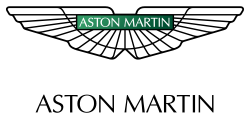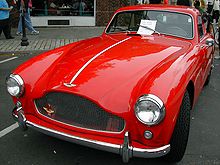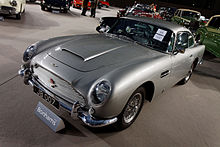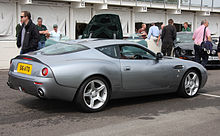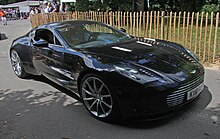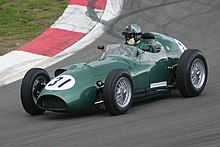Aston Martin
| Aston Martin Lagonda Global Holdings plc
|
|
|---|---|
| legal form | PLC |
| ISIN | GB00BFXZC448 |
| founding | 1913 in London (as Bamford & Martin Ltd. ) |
| Seat |
Gaydon , Warwickshire , United Kingdom |
| management |
|
| Number of employees | 2565 |
| sales | £ 997 million |
| Website | www.astonmartin.com |
| As of December 31, 2019 | |
Aston Martin is a British sports car manufacturer based in Gaydon in the English county of Warwickshire . The company was founded in 1913 by Lionel Martin and Robert Bamford as Bamford & Martin Ltd. founded. In 1915 the first car with the brand name Aston-Martin was built. The brand claimed to build racing cars for the road and was therefore heavily involved in motor racing . Until the Second World War, only a few hundred emerged Aston Martins .
In 1947, British entrepreneur David Brown took over the company. His initials DB can still be found in the model names today. Although his era was accompanied by racing highlights and a successful model policy, Brown had to sell the company in 1972 because of financial problems. In 1987, the US company Ford initially took over 75% of the Aston Martin shares and in 1994 the rest.
By its 80th anniversary in the mid-1990s, the company had only produced around 16,000 cars. The sports car brand from the then Newport Pagnell production facility became famous primarily for the films about the fictional British secret agent James Bond . Her Majesty's secret agent drove for the first time in Goldfinger (1964) in an Aston Martin , the DB5 .
In March 2007 Ford sold the majority of the shares in Aston Martin to a consortium around the British racing company Prodrive , chaired by CEO David Richards . In December 2012, the Italian private equity fund Investindustrial signed an agreement to acquire 37.5% of the shares. The company invested £ 150 million in a capital increase. In August 2018, the company announced that it would go public that same year. The company has been listed on the London Stock Exchange under the name Aston Martin Lagonda Global Holdings plc since October 3, 2018 .
history
From the foundation to the Second World War
Aston Martin's corporate history begins in 1913. The founders Lionel Martin (1878–1945) and Robert Bamford (1883–1942) founded the company in January 1913 under the name Bamford & Martin Ltd. started a small business in Singer vehicles on Callow Street in West London . Lionel Martin took part in various races with these cars, but then decided to make better and more race-worthy vehicles himself. After Lionel Martin had won the Aston Hill Climb mountain race in May 1914 on a 10 hp Singer he had tuned , the idea for the name of his own vehicle construction arose: Aston Martin . In the same year an article appeared in the trade press about Bamford & Martin's plan to manufacture their own automobiles under the brand name Aston-Martin (at that time still with a hyphen).
The young company found new domicile at Henniker Place in West Kensington . In March 1915, the first Aston Martin was registered, a prototype nicknamed the "Coal Scuttle". A second prototype was not built until the end of 1920 at the location in Kensington's Abingdon Road, which was recently occupied. Robert Bamford had just left the company at that time, as he had little interest in the planned series production of automobiles. The American millionaire's son Count Louis Vorow Zborowski (1895–1924), who also provided many a financial injection for the company, took his place. As a racing driver , Zborowski achieved his first major success for Aston Martin in May 1922 when he broke ten world records in the Brooklands Oval with an average speed of 122 km / h. In October 1924 the count was killed at the Italian Grand Prix in Monza , and Lionel Martin got more and more financial difficulties. Even new donors could not stop the bankruptcy in 1925. Martin left his company; he died 20 years later in a traffic accident on Gloucester Road in Kingston .
Lord Charnwood had already financially supported Aston Martin several times and took over the company. Together with Domenico Augustus Cesare "Gus" Bertelli and William Somerville Renwick, he started the newly founded Aston Martin Motors Ltd. in October 1926 at a new company location on Victoria Road in Feltham , Middlesex . (the company now bore the name of its products) to build new models. Bertelli and Renwick brought a self-developed 1.5-liter engine with four cylinders to the company. Lord Charnwood contributed at least a good name. On this basis, from 1927 onwards, Aston Martins were successively produced under the type designations “International”, “Le Mans”, “Mark II” and “Ulster”. From then on, Aston Martin racing vehicles collected victory points in all known car races, from the RAC Tourist Trophy to the Mille Miglia to the 24-hour races of Le Mans and Spa-Francorchamps . The greatest pre-war success was the 3rd overall place of an Aston Martin 1.5-liter Ulster at the 24 Hours of Le Mans in 1935. The bodies of these sports cars and the production vehicles were supplied by E., led by Gus Bertelli's brother "Harry", during this period . Bertelli Ltd. The British kit car manufacturer NG Cars successfully offered replicas of these sports cars in the 1980s.
Aston Martin Motors Ltd. - on the verge of bankruptcy due to the consequences of the global economic crisis - found a new main shareholder at the end of 1932: Sir Arthur Sutherland, who entrusted his son Gordon with the management of the company. At the end of 1935, the 1.5-liter engine had become obsolete and the development of a 2-liter engine began. In addition, from 1936 onwards it was decided to build more “civil” vehicles. On the basis of the new model 15/98, open four-seater, drophead coupés and saloons were created. Transferring the brand's reputation from the racetrack to the road was so exemplary that as early as May 1935 a small community of enthusiastic supporters formed the world's first automotive brand club at The Grafton Hotel on London's Tottenham Court Road: the Aston Martin Owners Club (AMOC) today has almost 5,000 members worldwide.
Aston Martin has now withdrawn from racing and left the field to private drivers. In 1936 “Gus” Bertelli, who was called “Our Bertie” internally, left the company, and the relationship with the body manufacturer E. Bertelli also ended. He had made a major contribution to the early Aston Martin racing era. Aston Martin made a name for itself on the world's race tracks in the 1920s and 1930s and had survived despite financial constraints.
With the development of the "Atom", Aston Martin wanted to bring future-oriented technology with modern streamline design to the road. But when the prototype was created in the spring of 1939, Gordon Sutherland and his designer Claude Hill no longer had time to develop the vehicle for series production. From 1941 to 1946 there was no further work on the "Atom". Since the company was founded until 1945, only around 700 Aston Martin vehicles have been built. On average, a new Aston Martin has only been produced every two weeks since 1919.
The David Brown era
After the war, work on the “atom” didn't really get going. Aston Martin did not fare badly financially through the production of armaments during World War II, but also not so well in developing a completely new production model for the post-war period. So Sutherland put Aston Martin up for sale in a newspaper advertisement. In February 1947 the hour of David Brown (1904-1993) struck. The British entrepreneur had previously made good money selling tractors, among other things , and had long had a penchant for sporty automobiles. He bought Aston Martin Motors Ltd., offered by Gordon Sutherland, for £ 20,000. and shortly afterwards also took over Lagonda . Lagonda, a company based in Staines near London , was able to offer a six-cylinder DOHC engine designed by the then legendary Walter Owen Bentley .
Former Aston Martin owner Gordon Sutherland and designer Claude Hill remained on the company's board of directors, and production of the new 2-liter sports model as a Drophead Coupé began as early as 1948. Unofficially, the model is also called Aston Martin DB1 , where DB stands for David Brown. The factory itself never referred to this model as DB1.
Racing was also resumed. In 1948 Leslie Johnson and John "Jock" Horsfall won the Spa-Francorchamps 24-hour race . But Horsfall had a fatal accident in a later race. Shortly afterwards, David Brown became aware of the talented mechanic and racing strategist John Wyer and brought him to his racing team in 1950. By 1963, the two became an extremely successful duo in racing.
Now Brown wanted to part with the four-cylinder engine developed for the "Atom" as soon as possible, which did not convince him at all in 2-liter sports. Two essential components for a promising new model were already in place: the chassis from the "Atom" and the engine from Lagonda. The gray cast iron 2.6 liter six-cylinder had an output of 105 hp. In April 1950 the DB2 was announced. This new vehicle took victory in the up to 3 liter class and fifth place in the overall standings back in June, once again at Le Mans . The following year, the new head of the Aston Martin works team, John Wyer, repeated the success with his drivers. In December 1950, the American racing driver Briggs Cunningham used the first Vantage produced in the first race at Sebring; he finished second in class D and seventh overall.
The Austrian Eberan von Eberhorst , who had previously designed with Ferdinand Porsche for Auto Union , launched the DB3 in 1951 as an independent racing car not based on a production vehicle. This is why this car also features typical Porsche design features: double-tube ladder frame, torsion bar suspension and trailing arm front axle . But despite technical refinements and an increase in displacement to 3 liters, the DB3 was not a sporting success. Von Eberhorst soon returned to Germany to resume work at Auto Union, which was newly founded in the west.
1955 began the development of the DB2 successor called DB4. In the same year David Brown took over the coachbuilder Tickford in Newport Pagnell in order to make himself more independent from subcontractors . Aston Martin gradually moved there until the old Feltham branch was finally given up in December 1963. When the new Aston factory opened in Gaydon in 2003, Newport Pagnell was only used until production of the Aston Martin V12 Vanquish ended in summer 2007 and was then largely demolished. When the DB4 was presented at the London Motor Show in 1958, it had elegant lines from Carrozzeria Touring and a new six-cylinder aluminum engine with a displacement of 3.7 liters from Tadek Marek .
In the years 1954 to 1957, the racing successes failed due to the fierce competition from Ferrari , Mercedes-Benz , Jaguar and Maserati . Between 1957 and 1959, Aston Martin achieved numerous successes with the redesigned Aston Martin DBR1 racing car , including a double victory at the Le Mans 24-hour race and the brand world championship in the same year.
The next model, the DB5 , appeared in October 1963 with a four-liter engine and the choice between a three-speed automatic or a manual five-speed transmission from ZF . With this car, Aston Martin shifted the focus from the race track to series production for the first time. Demand increased, and Aston Martin had finally risen to the circle of exclusive sports car series manufacturers. Production was doubled, and one of the 1,021 copies produced further consolidated the brand's fame: In the James Bond films Goldfinger from 1964 and Thunderball from 1965, a DB5 was the company car from 007 , subtly equipped with special equipment by Q. As a toy model with a functioning ejection seat in 1:43 scale from Corgi , this Aston Martin conquered countless children's rooms at the time.
The DB6 followed as early as 1965, which remained on offer in the further developed form as the Mk II until 1970. For the first time under the aegis of David Brown, a convertible version was also offered under the name “Volante” , after all with an electrically operated convertible top - a first for a European production vehicle. The DB6 has recently presented itself as a real four-seater.
In 1967 the DBS model broke with the lines that had been heavily influenced by Italian until then: the new, in-house design came from William Towns . But it wasn't until 1969 that Tadek Marek's new 5.3-liter V8 engine was ready. The type designation was then changed to DBS V8, but the six-cylinder DBS continued to be produced in parallel with the DBS-V8. From 1971, the financial situation at Aston Martin became precarious again: David Brown made less and less profits with his agricultural machinery, which until then had supported the commitment at Aston Martin and Lagonda . Aston Martin Lagonda Ltd. In spite of a turnover of 3.2 million pounds, it caused approximately 1.2 million annual losses. David Brown decided to sell it in 1972.
This ended, at least for most of the brand's enthusiasts, the “most glamorous era” of Aston Martin. The first 25 post-war years brought the brand great racing successes and a first-class reputation as a sports car manufacturer. For just £ 100, Aston Martin Lagonda Ltd. In early 1973 to Company Developments, an association of business people from Birmingham .
Eventful years
David Brown stayed with the company as a board member for the time being. After a short stop, production started again after six weeks. Personnel were cut, the abbreviation DB quickly disappeared from the type designations, and in May 1972 modified versions of the existing Vantage and V8 series appeared . The Birmingham Businessmen Consortium was unsuccessful, however. On December 30, 1974, a bankruptcy administrator was appointed, and in keeping with the prevailing zeitgeist, many contemporaries followed the decline of the luxury automobile manufacturer with malice. In addition, there was an economic crisis that hit England all year round and made around 175 Aston Martin employees fear for their jobs.
In mid-1975, the last-minute rescue came from two overseas businessmen: Peter Sprague, a US corporate renovator, and George Minden, a Canadian restaurant owner and Rolls-Royce dealer, took over. From 1976, business slowly got going again. Due to the strict US emissions standards, Aston Martins could no longer be sold in North America for some time. Technical optimizations and changes to the carburettors helped to obtain better values, and export to the USA was resumed. Despite this, the economic environment for luxury sports cars remained rather unfavorable.
A very modern car was presented under the name Lagonda in October 1976, and series production began around two years later. This new four-door luxury sedan with the technology of the V8 sports car should pave the way for the company in the future. Its sales successes, especially in the Near and Middle East, saved the company over the next few years. Sprague and Minden left the company anyway and left the management to their partners Victor Gauntlett and Tim Hearley. There were several changes of ownership until 1984, and finally, in 1985, Aston Martin was owned by Victor Gauntlett and Peter Livanos . As a result of these events, vehicle development at Newport Pagnell suffered . In addition to the Lagonda, the V8 in its variants Saloon (Coupé), Volante (Cabriolet) and Vantage (Saloon with modified body and higher performance) remained unchanged until the mid-1980s. In the 1980s there was a revival of the connection to the Italian body manufacturer Zagato , which had already produced a specially body sports car with the DB4 GT Zagato 20 years earlier : from 1987 to 1990, only a few examples of the contemporary design were produced in two limited editions The V8 Zagato model , which used conventional V8 technology and, especially in the convertible version, is now one of the sought-after classics.
Aston Martin directed by Ford
In 1987 there was a glimmer of hope: at the Mille Miglia , Victor Gauntlett met Walter Hayes, the former vice-chairman of Ford of Europe . There he talked about his worries that Aston Martin could soon no longer exist without a strong partner behind them. Hayes then proposed to Henry Ford II to join Aston Martin. Ford agreed, even though the company was once again a recovery case. The V8 model series has been revised again, the engine received a new injection, and the interior was slightly changed. Special versions of the V8 Volante, the Vantage Volante with Vantage-typical fender flares and spoilers as well as the higher performance and a Prince of Wales series named after Prince Charles with Vantage technology, but not widespread and spoiled design and an even more noble interior, led the Discontinuation of the V8 series.
In 1989 a new model was ready: the Virage . It had a new body structure and a revised V8 engine. There was also a Volante version of this series from 1992 and a Vantage version from 1993.
Walter Hayes, director of Aston Martin since 1987, invited Sir David Brown to Newport Pagnell on the occasion of his 89th birthday on May 10, 1993 . As a birthday surprise, the famous initials were reissued: David Brown himself suggested that the latest model be named DB7 . However, Brown would not live to see the start of series production, because he died in September of the same year. The DB7 became the most successful Aston Martin to date with over 6,000 vehicles built. It was a further development of a sports car developed by the Ford subsidiary Jaguar on the floor pan of the XJ-S , which was supposed to replace it and build on its E-Type, but could not have been sold at a price that was considered appropriate for Jaguar at the time . As an Aston Martin model, however, the price could be achieved. It was also more important for Ford to launch a second series at Aston Martin than to replace the XJ-S at Jaguar. The latter was instead revised in 1991 and only replaced by the XK8 in 1996 .
The designer Ian Callum redesigned the existing body structure of the prototype so that the car was recognizable as an Aston Martin. The engine was a six-cylinder in-line engine based on the Jaguar AJ16 engine with an Eaton compressor. Jaguar had already released this type of engine as the AJ6 in 1982; it was a tried and tested unit. It had an output of 246 kW in the DB7 (235 kW in the Jaguar sports sedans) and was thus only slightly behind the V8 of the Virage series, which was twice as expensive (257 kW). In 1999 the Jaguar V12, revised by Cosworth as Project SG , was installed. The new engine had an output of 309 kW at the time and was also installed in the Vanquish (2002) and DB9 (2004) models. With the Vanquish, an Aston Martin appeared in a James Bond film for the first time in fifteen years: In Die Another Day (2002), Pierce Brosnan drove a Vanquish called Vanish , which Q had equipped with a few extras that were unusual for Ford , including a camera system that made the car invisible. From July 2000 until his resignation in November 2013, the former Porsche Chief Technology Officer Ulrich Bez was the company's managing director. In September 2014, Andrew Palmer, coming from Nissan, took over this role.
Sale to a group of investors
On March 12, 2007 Ford announced the separation of the majority of the shares in Aston Martin. Two predominantly Kuwaiti investment groups - Investment DAR and ADEEN Investment , led by David Richards , took over the Ford shares. David Richards was also the CEO of Prodrive and Aston Martin. The purchase price was £ 475 million (just under € 700 million at the time). Ford retained an equity stake worth £ 40 million (just under € 59 million).
In the summer of 2007, after Vanquish production ended, the Aston Martin main plant in Newport Pagnell was closed and partially demolished to make way for a new development area. Aston Martins were only produced in Gaydon and from 2009 to 2012 by Magna Steyr in Graz .
In January 2009, Aston Martin announced that it would be competing in the Le Mans 24-hour race for the first time since its victory in 1959 . The car, developed in cooperation with Lola , Michelin , Koni and BBS , is powered by an Aston Martin engine and is to compete in the LMP1 class.
Based on the Toyota iQ , Aston Martin developed the Cygnet small car in order to meet European fleet consumption regulations. With the One-77 , a super sports car limited to 77 pieces, Aston Martin introduced the world's most powerful naturally aspirated car (559 kW / 760 hp) in 2009.
In 2011, a sports car sold under the revived name Virage appeared , which ranks between DB9 and DBS. From 2011 to 2013 Aston Martin was the main sponsor of TSV 1860 Munich .
Partnership with Daimler
On December 19, 2013, Daimler AG took over 5 percent of the British sports car manufacturer. As part of a technical partnership, Aston Martin will in future receive Mercedes-AMG engines from Daimler AG and will be involved in the development of the V8 engines.
As of 2018
As of October 3, 2018, the company's share has been listed on the London Stock Exchange under the name Aston Martin Lagonda Global Holdings plc .
At the end of May 2020, Aston Martin announced that AMG CEO Tobias Moers would take over the CEO position from Palmer.
Aston Martin in motorsport
Aston Martin was involved in various motorsport classes at the factory. After a wide-ranging sports car program, the company expanded its involvement in Formula 1 at the end of the 1950s.
formula 1
Aston Martin began developing its own Formula 1 racing car in the spring of 1956. A year and a half later, the first prototype was completed. It was originally intended to take part in the 1958 Formula 1 season with the car , but the project was postponed to focus on the World Sports Car Championship that year.
In 1959 , Aston Martin's works team appeared for the first time in Formula 1 under the name David Brown Corporation . The Aston Martin DBR4 was reported as an emergency vehicle , a conceptually outdated front-engine vehicle with a tubular space frame and a De-Dion rear axle . Factory drivers were Roy Salvadori and Carroll Shelby . The best results were two sixth places in the Great Britain and Portugal Grand Prix . For the 1960 season , Aston Martin developed the DBR5 , the wheels of which were individually suspended all around . The car appeared in only a few world championship races in 1960. His best result was Maurice Trintignant's 11th place in the British Grand Prix . Before the end of the season, Aston Martin stopped being involved in Formula 1.
For the Formula 1 World Championship in 2016 , the UK-based team Force India , which drives under an Indian license, tried to cooperate with Aston Martin. Force India's ideas were that Aston Martin should act as a name sponsor. At the end of December 2015, however, Aston Martin decided against a Formula 1 involvement with Force India. Instead, Aston Martin has been sponsoring the Red Bull Racing team, which drives with an Austrian license, since 2016 . The Aston Martin Valkyrie was created as part of this “Innovation Partnership” . Since the 2018 season the team has been registered as "Aston Martin Red Bull Racing". As part of this sponsorship, a joint development center is being created from which Aston Martin's series vehicles will benefit. Engine supplier for the team since 2019 but Honda .
In April 2020 it was officially confirmed that Aston Martin will return to Formula 1 for the 2021 season . The previous Racing Point team will therefore compete as the Aston Martin works team. Previously, the owner of Racing Point , the Canadian businessman Lawrence Stroll, was appointed CEO of Aston Martin Lagonda.
Sports car racing
In the 1950s, the main focus of the works team was on sports car races. Aston Martin invested a lot of money in the development of high-performance factory cars. The commitment reached its peak in 1959, when Aston Martin won the Le Mans 24-hour race and, at the end of the year, the Manufacturers' World Championship.
In the 1970s, the Aston Martin name returned to the world of sports car racing. The approach was a private project of the Aston Martin dealer Robin Hamilton, which, however, received factory support in various stages. Hamilton started in various races with a vehicle called Aston Martin DBS V8 RHAM1 , which was based on an Aston Martin DBS V8 built in 1972 and has been continuously developed over the years.
Hamilton entered the RHAM1 for the Le Mans 24-hour race in 1977 . The car had an aerodynamically revised compared to the standard models, forward sloping front end and was equipped with the 5.3-liter eight-cylinder engine, four Weber - carburetor was ventilated. The engine's output was given as 520 hp; the top speed was 303 km / h. After problems with classification and qualification, the car was finally approved for the race. The drivers were Hamilton and Mike Salmon. They finished the race in 17th place overall.
For the 1978 Le Mans 24-hour race , Hamilton fitted the RHAM1 engine with a turbocharger. This should increase the power to 800 hp. The charged engine consumed 120 liters of petrol per 100 kilometers in a test drive. Since the RHAM1 was not competitive in this form, Hamilton withdrew the report shortly before the start of the race. In the following year , the RHAM1 was equipped with petrol injection. Hamilton, Mike Salmon and Dave Preece had to struggle with the overweight of the car and insufficiently dimensioned brakes. After three hours the team gave up.
Aston Martin will drive in the DTM for the first time in the 2019 season. In cooperation with HWA and R-Motorsport, Aston Martin plans to field four cars in the DTM in the medium term.
Victories in the sports car world championship
| year | run | vehicle | Driver 1 | Driver 2 |
|---|---|---|---|---|
| 1953 | RAC Tourist Trophy | Aston Martin DB3 S. |
|
|
| 1957 | 1000 km race at the Nürburgring | Aston Martin DBR1 |
|
|
| 1958 | 1000 km race at the Nürburgring | Aston Martin DBR1 / 30 |
|
|
| RAC Tourist Trophy | Aston Martin DBR1 / 30 |
|
|
|
| 1959 | 1000 km race at the Nürburgring | Aston Martin DBR1 / 30 |
|
|
| Le Mans 24 hour race | Aston Martin DBR1 / 30 |
|
|
|
| RAC Tourist Trophy | Aston Martin DBR1 / 30 |
|
|
|
| 1963 | Coppa Inter-Europa | Aston Martin DP214 |
|
Vehicle types and years of construction
| 1914-1921 | "Coal Scuttle", various racing and test cars |
| 1923-1925 | Lionel Martin Series |
| 1927-1932 | 1.5-liter Tourer & Sports, International (from 1929) |
| 1932-1933 | Le Mans |
| 1934-1935 | Mark II, Ulster |
| 1936-1939 | Open Sports Tourer |
| 1936-1940 | 2-liter Speed, 15/98, C-Type |
| 1939-1946 | atom |
| 1948-1950 | 2-liter Sports (DB1) |
| 1950-1953 | DB2 |
| 1951-1953 | DB3 |
| 1953-1955 | DB2 / 4 |
| 1953-1956 | DB3 / S |
| 1955-1957 | DB2 / 4 Mark II |
| 1956 | DBR1 / 300 |
| 1957-1959 | DB2 / 4 Mark III |
| 1958-1963 | DB4 |
| 1959-1963 | DB4 GT |
| 1961-1963 | DB4 GT Zagato |
| 1961-1964 | Lagonda Rapide |
| 1963-1965 | DB5 |
| 1965-1969 | DB6 |
| 1967-1972 | DBS |
| 1969-1970 | DB6 Mark II |
| 1969-1977 | DBS V-8 |
| 1972-1989 | V8 , V8 Vantage (from 1977), V8 Volante (from 1979), V8 Vantage Zagato (from 1986) |
| 1976-1989 | Lagonda (4-door luxury sedan, in three series) There was also a Lagonda based on DBS. |
| 1980 | Bulldog |
| 1989-1994 | Virage |
| 1992 | 4-door sedan based on Virage (quasi the Lagonda successor, a shooting brake has also been created) |
| 1993 | Lagonda Vignale by Ghia |
| 1992-2000 | Virage Vantage |
| 1996-2000 | V8 Coupé and V8 Vantage (V600) |
| 1994-2000 | DB7 |
| 1999-2003 | DB7 V12 Vantage |
| 2000 | Lagonda Shooting Brake - a Lagonda Series III converted into a station wagon by Roos Engineering with the interior of a Series IV Lagonda. |
| 2001-2004 | V12 Vanquish |
| 2003-2004 | DB7 Zagato, DB AR1 |
| 2004-2016 | DB9 as a Coupé and Volante |
| 2005-2017 | Vantage series |
| 2006 | DBS (produced for the James Bond film Casino Royale ) |
| 2007 | Rapide (study) |
| 2009–2012 | One-77 |
| 2011-2013 | Cygnet |
| 2011–2012 | V12 Zagato |
| 2011–2012 | Virage as a Coupé and Volante |
| 2012-2018 | Vanquish as a coupé and a Volante |
| 2013-2018 | Rapide S. |
| 2013-2017 | V12 Vantage S as a coupé |
| 2015 | DB10 as a coupé |
| 2015-2016 | Vulcan as a coupe |
| from 2016 | DB11 as a Coupé and Volante |
| 2016-2018 | Vanquish Zagato as Coupé, Volante and Shooting Brake |
| from 2017 | Vantage as a coupe |
| from 2018 | DBS Superleggera as a coupé |
| from 2019 | Valkyrie as a coupe |
| from 2020 | DBX |
| from 2020 | DBS GT Zagato as a coupé |
| from 2021 | V12 Speedster |
literature
- Andrew Noakes: Aston Martin. The DB models . Heel Verlag, Königswinter 2017, ISBN 978-3-95843-599-5
- Andrew Whyte: Aston Martin DBs and Lagonda. Heel, Königswinter 1989, ISBN 3-922858-74-0 ( Collector's guide 8).
- Henry Rasmussen: Aston Martin. All series sports cars after 1945. Motorbuch, Stuttgart 1992, ISBN 3-613-01474-2 .
- Jonathan Wood: Aston Martin DB4, DB5 & DB6. The complete story . The Crowood Press, Marlborough 2000, ISBN 1-86126-330-9 .
- Michael Schäfer: Aston Martin. Series models since 1948. Motorbuch-Verlag, Stuttgart 2016, ISBN 978-3-613-03905-6 ( type compass , basic knowledge for car enthusiasts ).
- Michael Schäfer: Aston Martin & Lagonda. Series models since 1948. Motorbuch-Verlag, Stuttgart 2008, ISBN 978-3-613-02928-6 ( type compass , basic knowledge for car enthusiasts ).
- Michael Schäfer: Aston Martin Lagonda Ltd. in Newport Pagnell. One-time edition. Schäfer, Fürth / Odenwald 1999, ISBN 3-9806142-0-4 .
- Rainer W. Schlegelmilch, Hartmut Lehbrink: Aston Martin. Könemann, Cologne 2000, ISBN 3-8290-4832-7 .
- Rainer W. Schlegelmilch, Hartmut Lehbrink, Jochen von Osterroth: Aston Martin. Könemann, Königswinter 2005, ISBN 3-8331-1058-9 .
- Ulrich Bez: Making Aston Martin . teNeues Verlag, 2013, ISBN 978-3832795429 .
Web links
- Aston Martin Lagonda Ltd.
- Aston Martin Racing Team
- Aston Martin - Latest articles, driving reports, video clips and picture galleries
Individual evidence
- ↑ 2019 ANNUAL REPORT. (PDF; 3.1 MB) p. 142 , accessed on July 19, 2020 (English).
- ↑ 2019 ANNUAL REPORT. (PDF; 3.1 MB) p. 126 , accessed on July 19, 2020 (English).
- ↑ Aston Martin Homepage - History Timeline , English, HTML with Flash, accessed September 20, 2010.
- ^ Aston Martin shares fall on stock market debut
- ↑ astonmartins.com: Aston Martin Lagonda prototype, 1976
- ^ Andrew Palmer is the new CEO of Aston Martin. In: astonmartin.com , September 2, 2014 (English).
- ^ Phillip Inman: Aston Martin in peril as owner Investment Dar runs out of cash. In: The Guardian . September 27, 2009, accessed December 30, 2012 .
- ^ Aston Martin sold to UK-led group. In: BBC News . June 12, 2007, accessed December 30, 2012 .
- ↑ 00-Heaven! Bond's Car British Again. In: Sky News . Retrieved December 30, 2012 .
- ^ Off for Newport Pagnell. (No longer available online.) In: auto motor und sport . July 19, 2007, archived from the original on November 25, 2015 ; Retrieved January 7, 2013 . Info: The archive link was inserted automatically and has not yet been checked. Please check the original and archive link according to the instructions and then remove this notice.
- ↑ Aston Martin to challenge for overall Le Mans. ( Memento of April 5, 2009 in the Internet Archive ) In: astonmartinracing.com , accessed September 20, 2010 (English).
- ↑ Nico Schmidt: Daimler seals entry into James Bond brand Aston Martin. In: finanzen.net , December 19, 2013.
- ↑ Tobias Moers: Quantum of consolation for Aston Martin: AMG boss becomes new CEO. Retrieved May 27, 2020 .
- ↑ Hodges: Racing Cars from AZ after 1945, p. 23.
- ^ Mike Lawrence: Grand Prix Cars 1945-65. , Motor Racing Publications (1999), p. 30.
- ^ Mike Lawrence: Grand Prix Cars 1945-65. , P. 29 ff.
- ↑ Dominik Sharaf: Too expensive: Aston Martin cancels Force India. Motorsport-Total.com, December 24, 2015, accessed January 18, 2016 .
- ↑ Aston Martin F1 Team Gearing up for 2021. Accessed April 1, 2020 .
- ↑ Official: Racing Point will become the Aston Martin factory team in 2021. Retrieved April 1, 2020 .
- ↑ Capital increase at Aston Martin: Stroll & Co. invest 600 million. Retrieved April 1, 2020 .
- ↑ Spiegel.de: Aston Martin enters the DTM . Retrieved October 31, 2018.
- ↑ Successes in the sports car world championship in 1953
- ^ Successes in the sports car world championship in 1957
- ^ Successes in the 1958 World Sports Car Championship
- ↑ Successes in the sports car world championship in 1959
- ↑ Successes in the sports car world championship in 1963
